Table of Contents
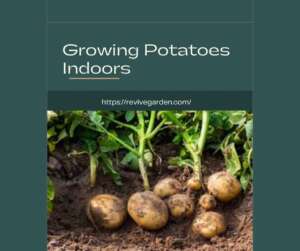
Potatoes are a cool-season crop that can be grown in various climates. You can grow potatoes indoors under lights or outdoors in the ground or containers. Growing potatoes indoors is an excellent option for late-season gardeners who want to get their hands dirty now and then but only have time for some of the planting, weeding, and harvesting that goes with outdoor gardening.
Potatoes grow best when temperatures are between 60 and 70 degrees F. (16 and 21 C.). They need about eight hours of sunlight daily and about 1 inch (2.5 cm.) of water per week.
What you’ll need To Grow Potatos Inside
Potatoes are easy to grow and don’t require any sophisticated equipment. Here’s what you’ll need:
- Seed potatoes with eyes
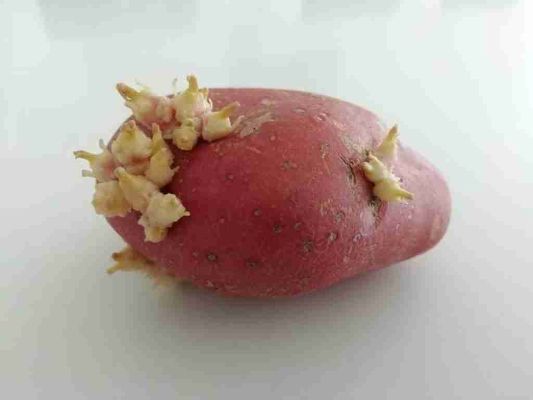
- Container
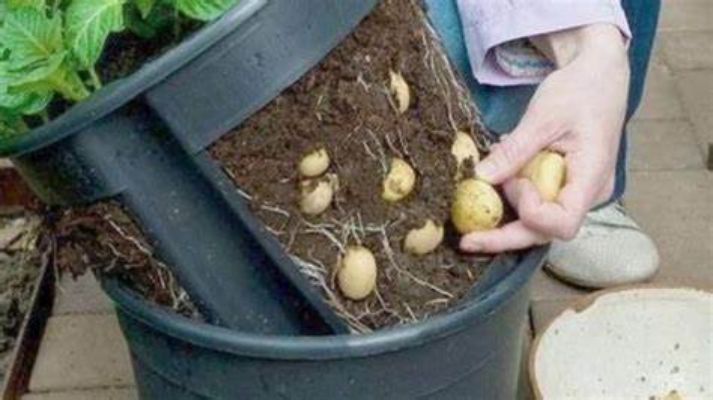
- Soil
- Water
What Are The Steps to follow For Indoor Potatos
Follow the steps to learn how to grow potatoes indoors:
1. Sprout the potatoes
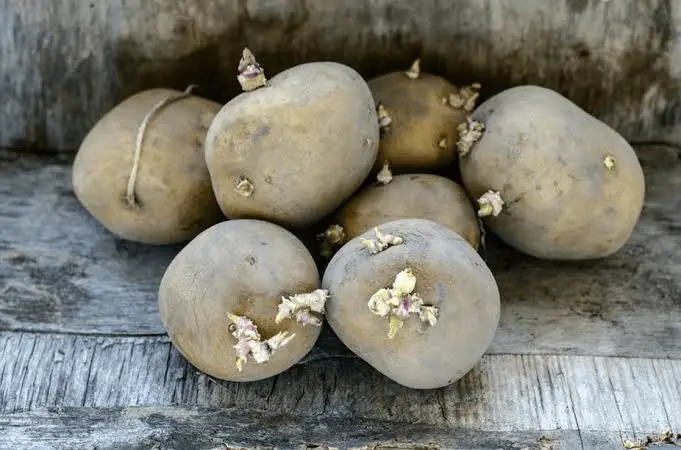
When you pay a visit to the grocery store to purchase potatoes that you’re going to plant, try to find ones with eyes. The white spuds on the potatoes that you can see in the picture above are called eyes. These are the points where germination will take place. The more eyes you can find on the potatoes that you buy, the better since they will produce a higher yield.
If the potatoes from the store aren’t sprouted yet, that’s alright too. Place these potatoes in a cool, dry place with ample sunlight. It’s better to place them in a container, but make sure they are dry. Leave them in this position for days, or weeks depending on the conditions. Once the sprouts have grown to about 1 inch in length, the potatoes are ready to be planted.
2. Prepare the sprouted potatoes
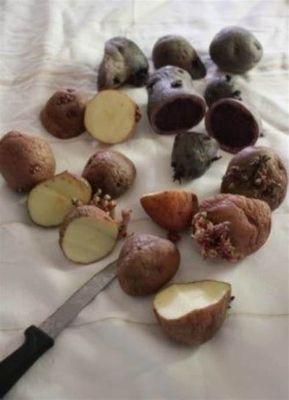
- If there are any large potatoes, cut them into pieces of about 2 square inches. Be careful not to cut through the sprouts since it will affect their ability to germinate.
- Each of the pieces or whole potato (for those that are small) should have around 2 to 3 sprouts. If there are too many sprouts, rub some of them out, or else the harvested potatoes will be too small.
- Now leave the cut-up potatoes for another few days or until they are dry and healed from the points they were cut.
3. Prepare the container
While waiting for the potatoes to be ready, you should have your container and soil prepared so that you are ready to plant the potatoes as soon as they are sprouted and healed.
The good thing is, you don’t need anything fancy to plant potatoes. If you don’t have a gardening pot available, even a plastic bucket will do. You can also use an empty fertilizer bag to grow potatoes!
The only things you need to make sure of are:
- Large capacity: Make sure that the container is large enough to grow a good yield. 9 to 10 lbs is the ideal size for a container to grow potatoes indoors.
- Suitable height: Choose a container with walls that are several inches in height since you’ll be adding in more soil as the potatoes grow, you’ll need sufficient space for doing so.
- Drainage hole: If the container you choose does not already have a drainage hole, you’ll need to drill one.
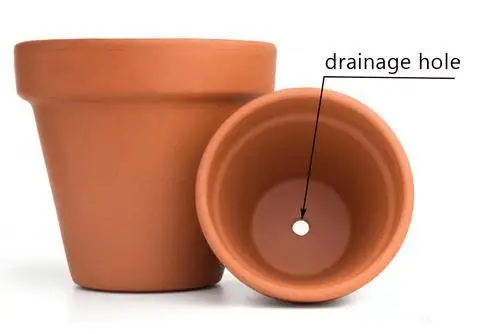
Once you have picked the right container, cover the base with some pebbles for proper drainage. Next, add in loose potting soil until the container is one-third full.
4. Plant potatoes
Once everything is ready, it’s time to plant the potatoes! Follow the steps to plant your first batch of potatoes:
- Place three to four potatoes over the layer of soil, with the sprouts pointing upwards.
- Cover the potatoes with another layer of potting soil.
- Water the soil to make it moist.
- Place the container at a spot where it gets plenty of sunlight.
5. Water the plant
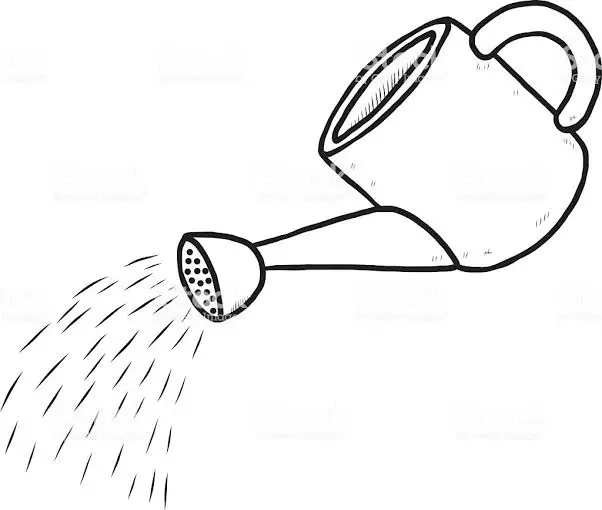
It will take about ten weeks for the potatoes to be ready for harvest. Before that time, you will need to tend the plant and maintain optimal conditions.
- Check the moisture of the soil at least twice a day and water it, if required, just enough to make the soil moist.
- As the plant grows, after every few inches of growth in its height, you need to pile up soil around the plant. This is called hilling the potatoes. Make sure that the potatoes don’t rise above the level of the soil.
- Continue hilling the potatoes until the tips of the plant turn yellow.
6. Harvesting the potatoes
When the tips of the plant turn yellow, we are ready to harvest our potatoes! If you want small, fresh potatoes, harvest them as soon as you see the tips turn yellow. For larger potatoes, you may wish to wait another week before harvesting.
- Pull out the plant, or plants, from near the soil.
- Pick out the spuds from the roots and brush off the soil.
- Let them dry in the sun before cooking them.
7. Ready to eat
All done! Your homegrown potatoes are ready to be cooked. Boil them, fry them, bake them with cheese or cook them with fish! The possibilities are endless. No matter which recipe you try out, the results will be phenomenal. You have, after all, spent time and effort in growing them in ideal conditions, not just grabbed them off a rack at the grocery store.
Growing Potatoes Indoors In Water
When growing potatoes indoors in water, there are no worries about having too little or too much water. You only need to check on your plants every few days and give them enough water to keep them happy. You won’t have to worry about over-watering either because they only need a cup or two of water at a time.
How to Grow Potatoes Indoors In Water Containers:
- Purchase certified disease-free seed potatoes from a reputable supplier.
- Select a container with drainage holes in its bottom and a lid that securely fits over the top. The container should be large enough to accommodate all your seed potatoes, plus extra room for growth. Tin cans are ideal, but you can also use plastic buckets or even old bathtubs if they have a secure lid that fits tightly over the top.
- Place one tablespoon of bone meal fertilizer into each hole and cover with soil before placing your seed potato. This will help to provide nutrients for growth once the plant begins sprouting green shoots above ground level (about 3 inches).
- Water the well until standing water is at least 2 inches deep inside each planting hole; then cover it with soil.
Potatoes are a root crop requiring rich, loose soil that drains well. To ensure good drainage, amend the soil with compost or manure before planting. Potatoes also need plenty of nitrogen to grow well.
In addition to being a good source of vitamins and minerals, potatoes contain antioxidants and anti-inflammatory compounds called phenolic acids that may help lower risk factors for cardiovascular disease, cancer, and diabetes.
FAQs
How To Grow Potatoes Indoors In Winter?
Finding time to get outdoors and tend your garden can be challenging in winter. The cold weather makes it difficult to grow anything outdoors, so many people look for other options when they want fresh produce. If you’re interested in growing potatoes indoors during winter months, there are some things that you should know first:
Potatoes need light to grow properly, so ensure your container has good ventilation and plenty of room for air circulation.
Potatoes like to be watered regularly but must also dry out between waterings. Keep an eye on the soil to determine when watering is needed most.
Make sure you use fresh potting soil or composted topsoil to give your potatoes a healthy start in life!
How Many Varaities If Indoor Potato Containers?
There are several varieties of indoor potato containers that you can use to grow potatoes indoors, including:
- Traditional Pots: You can use plastic, ceramic, or terracotta pots to grow potatoes indoors. Ensure the pot is at least 10 inches deep to provide enough space for the roots to grow.
- Grow Bags: Grow bags made of breathable fabric are another popular option for growing potatoes indoors. They are lightweight, easy to move, and allow for excellent drainage.
- Tower Planters: Tower planters are tall, vertical containers with multiple levels for growing plants. They are perfect for growing potatoes indoors, providing plenty of space for the plants to grow upward.
- Bucket Containers: You can also use 5-gallon buckets as containers for growing potatoes indoors. Make sure to drill holes in the bottom for drainage and fill the bucket with potting soil.
- Hydroponic Systems: Hydroponic systems are becoming increasingly popular for growing potatoes indoors. These systems use nutrient-rich water instead of soil to grow plants and can be highly efficient and productive.
How Long Do Potatoes Take To Grow?
It takes about six weeks from buying your seed potatoes until they are ready for harvesting. This will vary depending on the variety and time you spend watering and fertilizing them.
Will Store-Bought Potatoes Produce Potatoes?
Yes. You can produce potatoes from store-bought potatoes. The important thing is that the potato is not sprouted or rotten. If the potato has sprouted and you plant it, you will get a plant that looks like a weed and not a potato.
Can Potato Tubers Produce Potatoes?
Yes, they can. The tuberous root of a potato plant is called a potato tuber. The potato plant produces these tubers underground as it grows and stores food for itself during the winter months. They can be dug up any time during the growing season and planted to grow more potatoes in your garden, patio, or balcony.
How Long Does It Take for a Potato Tuber to Produce More Potatoes?
It takes about 100 days for a potato tuber to produce more potatoes after being planted in soil outdoors or in a container indoors. Suppose you want to grow more potatoes faster than this. In that case, you should try growing them indoors with grow lights so that they have enough sunlight every day during their growing season, which is around 100 days long, depending on where you live and what variety of potatoes you have planted.
How Long Do Potatoes Take To Grow Indoor?
The time it takes for potatoes to grow indoors can vary depending on several factors, such as the variety of potatoes, growing conditions, and the method of planting. It generally takes 2-3 months for potatoes to grow indoors from planting to harvest.
If you are growing potatoes from seed potatoes, it can take 1-2 weeks for the potatoes to sprout and begin to grow roots. Once the plants have established a robust root system, they will begin to grow foliage and eventually produce tubers.
The time it takes for the potatoes to mature and be ready for harvest can vary depending on the variety of potatoes and growing conditions. Most varieties of potatoes take between 70-120 days to mature. As the potatoes grow, you will notice the foliage begin to yellow and die back, indicating that the potatoes are ready to be harvested.
Conclusion
Growing potatoes indoors is just how simple as it sounds! You’ll do a fantastic job even if you haven’t planted ever before in your life. You will only need to give it a try! If it goes well, you can grow your indoor kitchen garden. Make sure it’s complete with all the veggies that you use most frequently in your kitchen.
